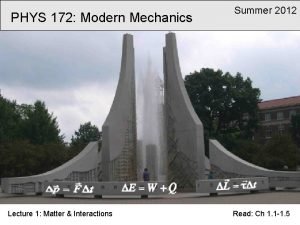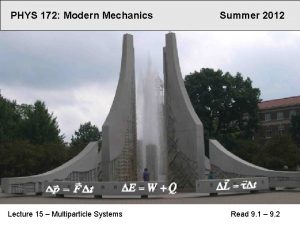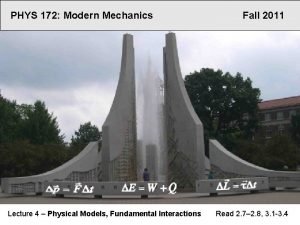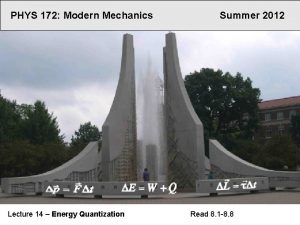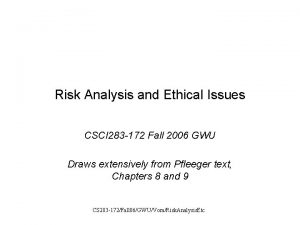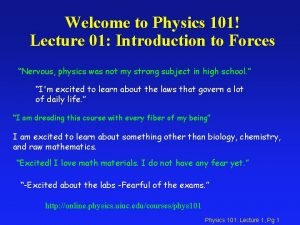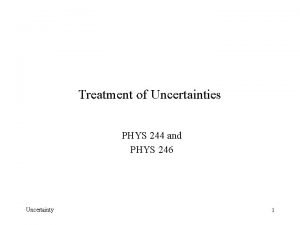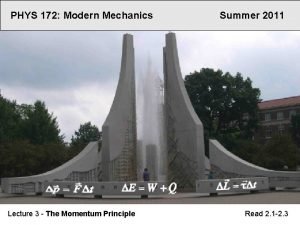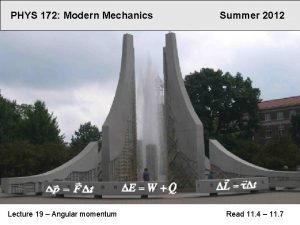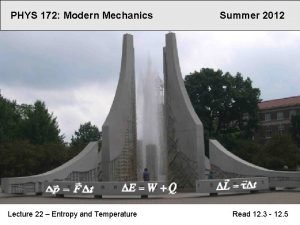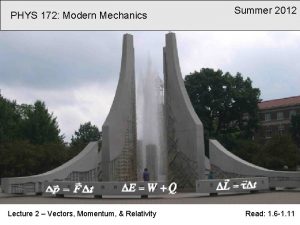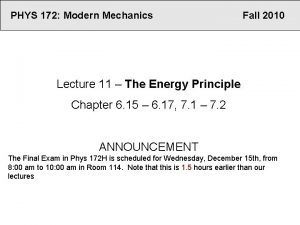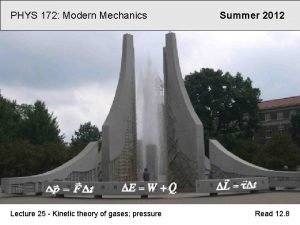PHYS 172 Modern Mechanics Lecture 4 Physical Models












- Slides: 12

PHYS 172: Modern Mechanics Lecture 4 – Physical Models, Fundamental Interactions Fall 2011 Read 2. 7– 2. 8, 3. 1 -3. 4

Predictions using the Momentum Principle The Momentum Principle Update form of the momentum principle Short enough, F~const For components:

Example k. S=500 N m. ion rict no f Force: provided by a spring stretched by L=4 cm interaction duration: 1 s ? Find momentum pf if pi=<0, 0, 0> kg. m/s 1. Force: NB: force must not change during t 2. Momentum: N. s = kg. m/s 2. s = kg. m/s

Physical models “Spherical cow” Ideal model: ignore factors that have no significant effect on the outcome

Example: colliding students Two students are late for class and run into each other head-on. Q: Estimate the force that one student exerts on the other during collision Simplest model: System: one spherical student Surroundings: earth, floor, air, second spherical student Force: Earth, floor, air, other student – unknown!

y Example: colliding students Strategy: x

Example: colliding students y Strategy: x What is the collision time? What is the initial momentum? Find F: Assume: vi =5 m/s, x=0. 05 m Assume: m=60 kg

Newton’s Great Insight: The force that attracts things toward the earth (e. g. a falling apple) is the same force that keeps planets orbiting about the sun

The gravitational force law m 2 Newton Cavendish Gravitational constant m 1 m 2 m 1

Predicting motion of a planet Where will the planet be after one month? Use position update formula: If we assume that velocity is constant Does not work because the force is changing the velocity! The force changes with position. The momentum changes with position. In general, there is no algebraic equation to predict motion of more than 2 interacting objects.

Iterative prediction of a motion of one planet Simple case: one planet star is fixed in space 1. Calculate gravitational force: 2. Update momentum Choose t short enough (F & p do not change much) 3. Calculate v and update position 4. Repeat Critical parameter: t

Iterative prediction of motion Real case: many objects are free to move 1. Calculate net force on each mass: 2. Update momentum of each mass Choose t short enough (F & v do not change much) 3. Calculate v and update position of each mass Iterative approach: works for any kind of force, not just gravity! 4. Repeat t is a critical parameter!
 Purdue physics 172 past exams
Purdue physics 172 past exams Particl clicker
Particl clicker Iterative prediction of motion
Iterative prediction of motion Phys 172
Phys 172 283+172
283+172 Charging by induction
Charging by induction 01:640:244 lecture notes - lecture 15: plat, idah, farad
01:640:244 lecture notes - lecture 15: plat, idah, farad What is modals and semi modals
What is modals and semi modals Uiuc phys 102
Uiuc phys 102 Physics 101 uiuc
Physics 101 uiuc Physics courses ucsd
Physics courses ucsd Calculating a percent difference
Calculating a percent difference Http //www.phys.hawaii.edu/ teb/optics/java/slitdiffr/
Http //www.phys.hawaii.edu/ teb/optics/java/slitdiffr/
